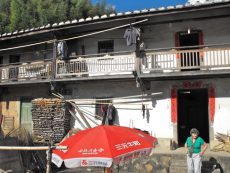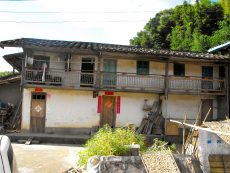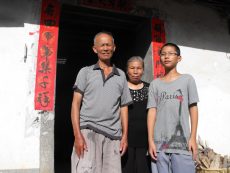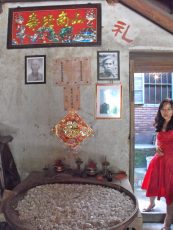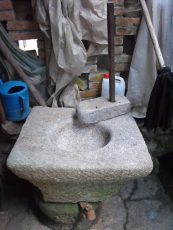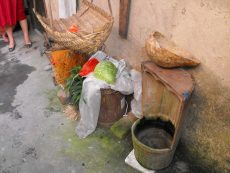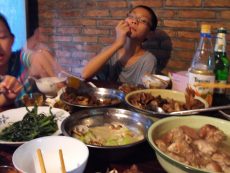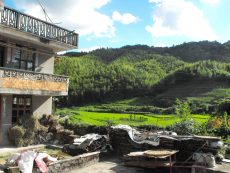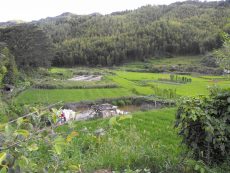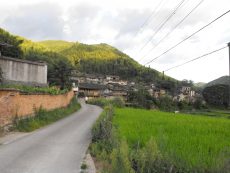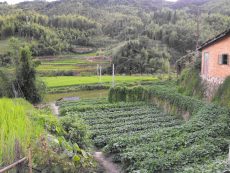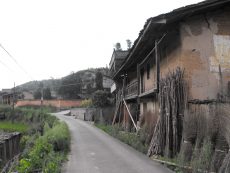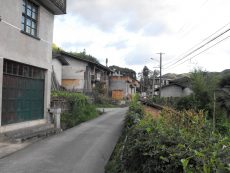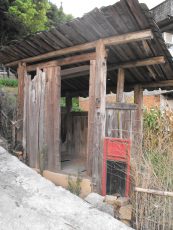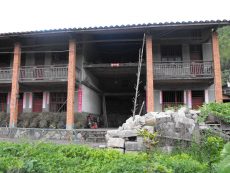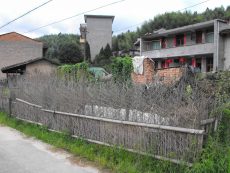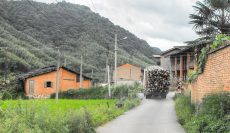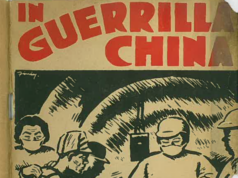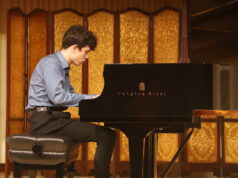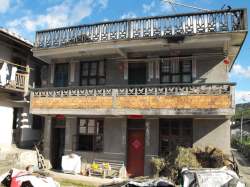
China in July, 2012, had been exhausting, and for nearly two weeks we had endured temperatures of 35deg.C on a regular basis and I was heartily sick of dragging myself around in the heat. Then Chinese friends (from Hwa Nan Women’s College, Fuzhou, where we were teaching) picked us up and promised us a day in the mountains close to Fuzhou, Fujian Province. We were driven for about an hour up the mountain roads round and around, the driver overtaking a trifle dangerously on tight bends, but managing nevertheless to feel fairly easy about it. The air began to feel clearer and a breeze sprang up, making the journey very pleasant after the humid heat of the city.
So it was pure delight to arrive in a tiny village in the mountains not far from Fuzhou. Shanliao, we were told, had a population of 30 inhabitants, although there had been more – many houses are now uninhabited. We had been invited to a farmer’s house for dinner – it turned out that our driver was the grandson of the farmer.
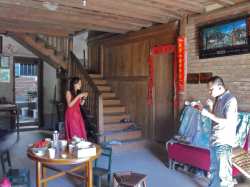
We were shown into the house, into a cool room, and were warmly invited to sit down. We were then given a sample of the family’s homegrown tea, which was wonderfully refreshing after our journey. It was Qing Ming tea, named after that Festival when it was picked from their own tea bushes, grown on the other side of the valley opposite the farmhouse. Soon we met the head of the house, Mr San, a sprightly wiry man who laughed all the time.. He told us he was 75 and spent most of his day working in the fields. They had been given [Editor’s note: perhaps in the land reforms] roughly 9 mu [= 9x 666m2 or about 1.5 acres] of land and every square inch of land was used for some crop or other. We looked across the valley and in the dip in front of the house, saw rice, not quite ready to harvest, but growing vigorously with the benefit of water from the drains, in small terraced fields. Large bamboo fences held pumpkins fattening on the vines and across the dip, the tea bushes were growing on narrow terraces up the valley side. As the eye rose up the hill, trees of some sort took over from the crops, giving a wonderfully green aspect to the whole area (see images below).
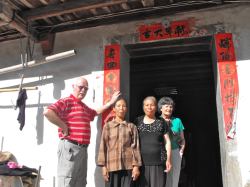
The house was surprisingly large, but the order of importance of the rooms was clearly utterly different from that in a western home. When one enters a western house, one is shown into the lounge where normally a comfortable settee awaits the guest, who can enjoy the various art displayed there and see the TV in the most important corner of the room. Here, the Chinese equivalent was dedicated to a far more utilitarian function and so furniture consisted of an old settee which proved to be exceedingly uncomfortable for spoilt westerners, who require a comfortable back to rest on, battered chairs, and an old bedstead made of woven bamboo with a sacking base. Hanging along the walls were a number of bamboo yokes, each normally for carrying two heavy baskets across the shoulders but now used as hooks to hang random plastic bags containing unknown ‘things’. Perhaps there was one for each family member. In front of the family altar to ancestors (photos of several adorned the wall) was a large threshing-type basket which had rice flour drying in it (for adding to soup for thickening, we were told). The walls were of brick with no pretence to embellishment such as paint or plaster and certainly no beautiful pictures or objects to look at. Besides a fancy clock showing a water-town scene (such as Suzhou?), the only decor was two certificate-like plates (each indicating that a member of the family was a Communist Party member:
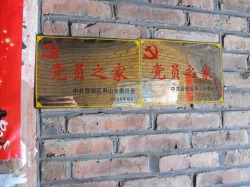
党员之家 Home of The Party Members
中共晋安区寿山乡委员会 Committee of The Communist Party in Shou Shan County of Jin An District), August 2010
The front door was permanently open to allow neighbours to wander in and out and a flight of wooden stairs, sturdily built but not decorated in any way, led upstairs.
We were then asked to go to dinner. This was in another building and one had to pass through an open-air space which turned out to be a food-preparation area with two large basins each with a cold-water tap, and a large mortar (for preparing sticky rice with a large stone mallet for crushing the first-cooked rice grains). This area also contained the bathroom and toilet rooms. Running though the area was a deep open drain for waste water running through it. This was crossed by a small bridge (and, looking up, by several footbridges at first floor (bedroom?) level). A surprising feature of one of the toilet rooms was a very smart modern western toilet, something quite rare in 80 percent of Chinese bathrooms that we have used (the usual Chinese toilet is a ground-level oblong bowl over which one squats and hopefully rises again without stepping into it and down which no paper must be put, paper being put in a bucket to be emptied later). Just to one side, the family asked us to identify what looked like a bucket-like barrel. They laughingly told it was for boys to do ‘pee-pee’!!
Dozens of fruit crates were stacked high to above our heads against the walls, ready to receive a harvest of oranges when the time was ripe.
In the dining room-come-kitchen, we were then invited to sit at an old battered table and we tucked in to a meal including a stew of chicken pieces (the chicken’s head and feet greeting us from the pot. We were told this was an old custom and was a welcome sign to guests). Not for the faint-hearted but it was wholesome and tasty if full of bones. Other dishes were another stew comprising huge pieces of pork fat and a dish of clams and bamboo shoots, and a bowl of greens, along with soup for afters. Drinks were beer and lemonade. We were sure that the family wouldn’t normally eat as well as that….
Only the guests were at table and we were told that traditionally the menfolk would normally dine separately from the women.
We found out that the family of 6 people – grandfather, grandmother, one son and wife (who we met) and two daughters (who were at work in Fuzhou, 26km away) – all live in the large family house. In fact we realised that the home comprised four buildings – two side wings for the junior members of the family? – with the middle two (separated by the open-drain and food-preparation and toilet area) being used mainly by the old farmer and his wife.
The whole family is virtually self-sufficient on what they grow on their land in terms of rice staple, vegetables, chickens (and hence eggs) and ducks.
Other protein (such as pork, beef and fish) is bought at a local supermarket. These and other luxuries are paid for by money earned by the daughters who work in Fuzhou 26 km away. They go to work in the commune-owned minibus [paid for by a special levy] for which they pay a fare.
As we left to go, thanking our hosts profusely for their hospitality, we were given a tour of the village and a chance to study the crops which they grew at close quarters. It was the first time I had seen paddy fields up close and had a chance to examine the little seeds of rice contained in the grass-like plant. Peanuts or groundnuts were spread out to dry in the sun and fences made of bamboo twigs were neatly tied ready for the next time they were needed to hold up a crop. We passed the communal toilets – a small wooden hut with slots in the floor and a bucket in the corner for used toilet paper. By the side of the road were several tiled rubbish bins for regular garbage collection.
As we sauntered up the village road several bamboo-laden trucks passed us – reflecting another local industry.
Unfortunately, we didn’t have time to visit other village amenities… However, we had had a fascinating insight into some aspects of Chinese rural life in a small corner of Fujian Province.
– Teri France


